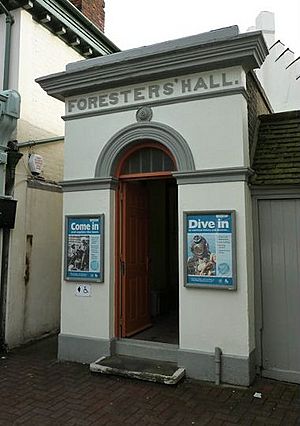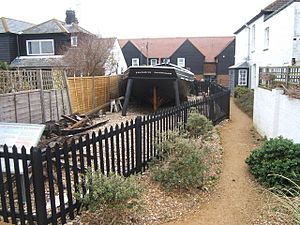Whitstable Museum and Gallery facts for kids

Museum entrance
|
|
| Established | 1985 |
|---|---|
| Location | 5A Oxford Street, Whitstable, Kent CT5 1DB, United Kingdom |
| Type | heritage centre; seafaring traditions museum |
| Collection size | Diving, oyster trade, shipbuilding trade, Peter Cushing, steam locomotive |
| Public transit access | Rail: Whitstable railway station Buses: National Express, Stagecoach |
The Whitstable Museum is a fun place to visit in Whitstable, Kent, United Kingdom. It's a heritage centre that shows off the town's amazing history. You can see one of the world's oldest steam engines, learn about the local oyster trade, and explore old diving gear.
Contents
Museum History
The museum you see today first opened its doors in 1985. It's located in a building that used to be called "Foresters' Hall" back in 1881. Even though the entrance looks small, it opens up into a big hall full of cool displays!
In 2001, the museum won a special award called the Nautiek Award. This award was for its great work in preserving diving history. It was the first time a UK museum had won it! The museum also got a makeover in 2015, thanks to some funding that helped make it even better for visitors.
What You Can See
The Whitstable Museum has many interesting things to explore. Its collections cover different topics like nature, the local oyster industry, and the early days of diving. There are also displays about the famous actor Peter Cushing, who lived nearby.
You can learn about the big floods of 1953, shipwrecks, and even maritime archaeology, which is like finding treasures from under the sea.
Famous Exhibits
One of the most exciting things to see is the 1830 steam locomotive called Invicta. This unique train used to run on the Canterbury and Whitstable Railway.
You can also see Whitstable's very first horse-drawn fire pump. Imagine, it needed twenty-six volunteers just to make it work! A fire insurance company gave it to the town in 1867.
Diving and Sea History
The museum has a cool display of standard diving dress. This includes a Siebe Gorman helmet and a traditional red bonnet. The bonnet was worn to protect the diver's head inside the heavy helmet.
You can also find pieces from the East Indiaman ship Hindostan. This ship was unfortunately wrecked near Margate in January 1803.
In 2010, the BBC picked some special "pudding pan pots" from the museum. These pots helped tell the story of Kent as part of a big project called "A History of the World in 100 Objects."
Art and Collections
The museum also has a collection of paintings. These include pictures of ships that show how Whitstable traded with other places. There are also views of the town, the shore, and the coast. You can see artworks by local artists and even some pieces borrowed from other galleries around the world.
Events and Exhibitions
The museum often hosts special events and exhibitions throughout the year. These can be about local history or even bigger topics that have traveled around the country.
For example, in 2001, there was an exhibition about art and water. In 2002, visitors could actually touch old diving equipment and watch films about diving. There have also been exhibitions about the last oyster yawl (a type of boat) called Favourite, and about the Girl Guides.
The museum is a big part of the yearly Whitstable Oyster Festival. During this festival, they often have fun, interactive exhibitions for everyone to enjoy. In September 2009, there was even a special exhibition about World War II and what it was like on the front lines.
Learning Space
In 2009, the museum created a special area just for education. This space is located at the front of the building on Oxford Street. It helps the museum offer more learning opportunities for visitors and groups.
Images for kids
-
1867 fire pump
-
Slipper limpets, blamed for the previous decline of the Whitstable oyster trade
-
Modern oyster fishing at Whitstable, 2007










